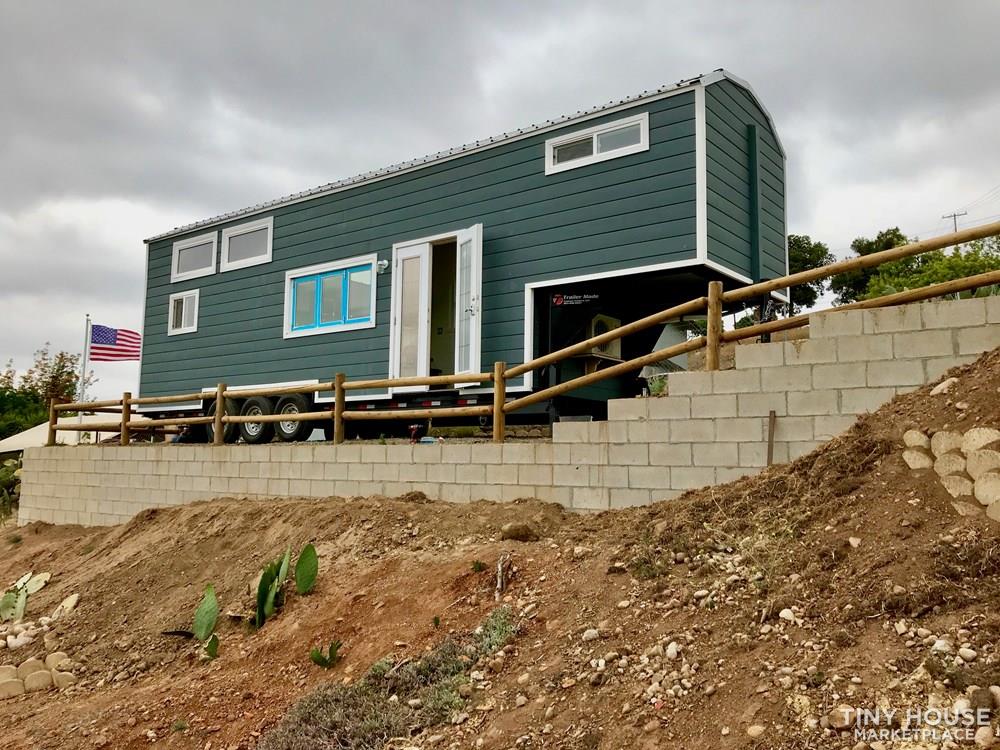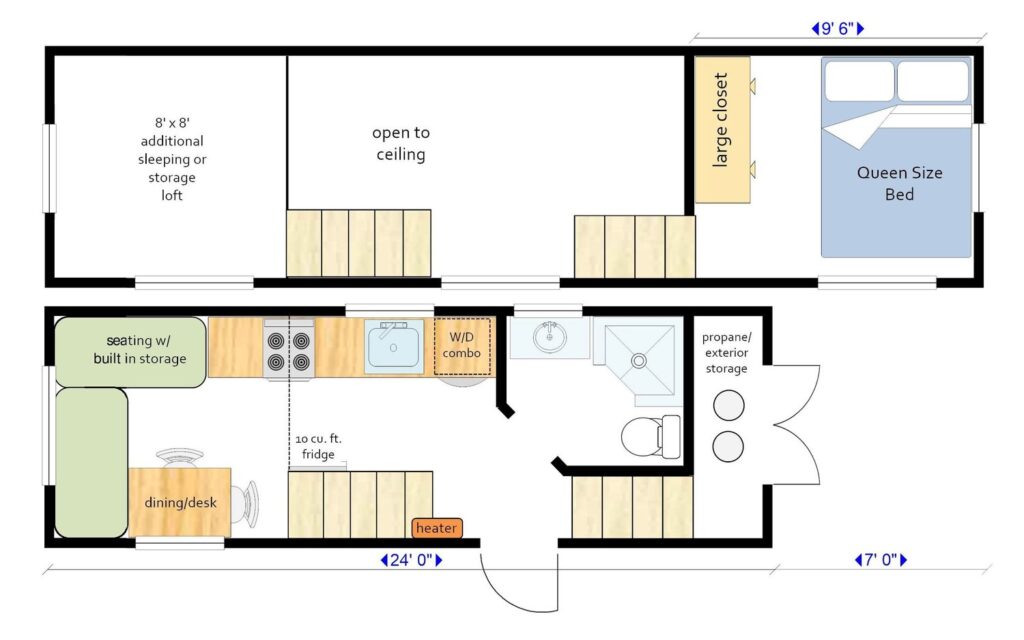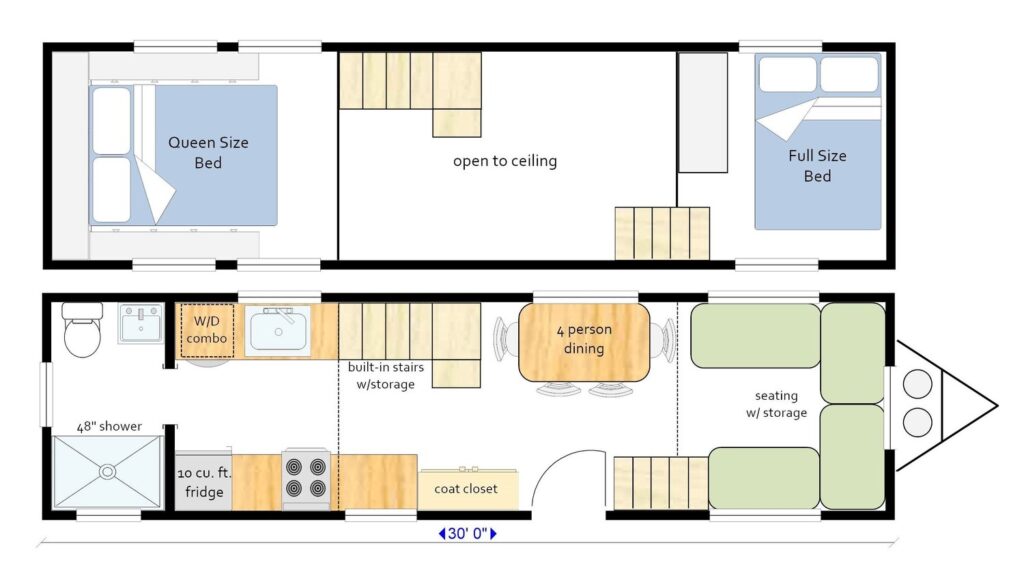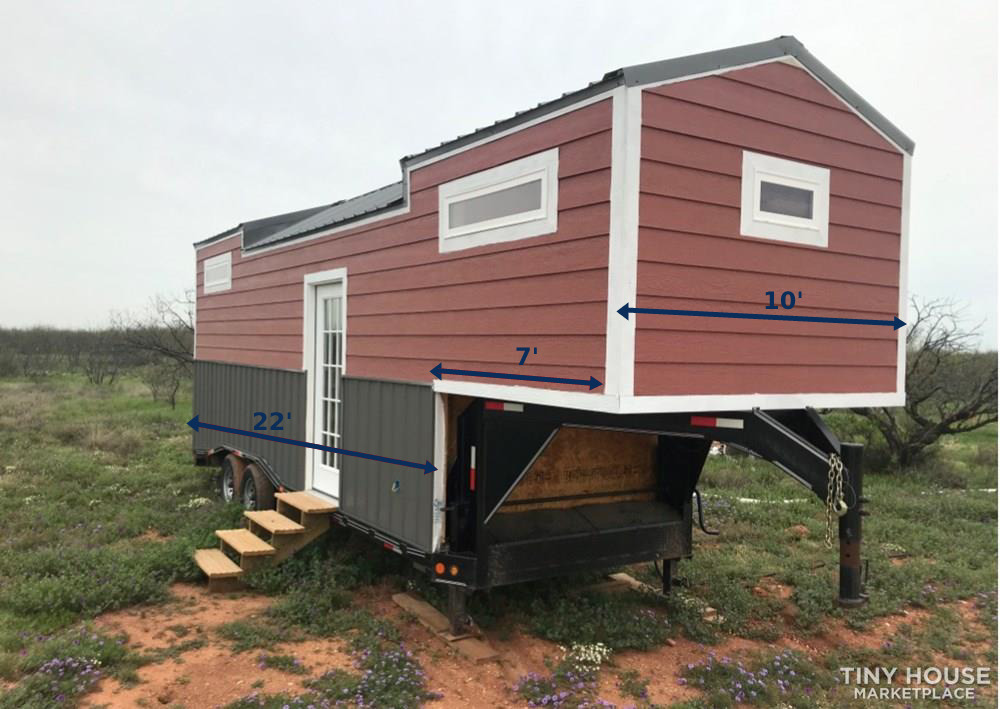Blog

Gooseneck Tiny Homes Guide (Includes Photos & Videos)
When exploring tiny houses, you might have come across ‘weird’ looking tiny houses which seem to have a ‘floating’ portion on one end of the building. These are called gooseneck tiny houses, and they are actually an ingenious innovation which offer various benefits over standard tiny houses.
Gooseneck tiny homes can offer a full-height master bedroom, less steps up to the bedroom (no need for a ladder) and they are easier to tow due to increased stability. Of course, they do also have some flaws.
So What Exactly Is A Gooseneck Tiny House?
A goose’s neck ‘sticks out’ over the rest of their body, and this is what happens with a gooseneck tiny house as well: it has a main body, and then part of the building hangs out over this as though it is floating in mid-air. It is built on top of a gooseneck trailer:

A key difference of a gooseneck tiny house (compared to a standard THOW) is that instead of it having a small trailer hitch on the bumper (and towing it with a truck), a gooseneck offers much more stable towing because the towing vehicle (probably a lorry) attaches through the bed of the vehicle.
In addition to this increased stability (and hence safety) when towing, the tongue of the gooseneck trailer also provides for an extra 5-10 foot of space to its tiny house owners. Check out the photos and videos below to get an idea of how they vary (compared to standard trailer tiny houses).
Photos Of Gooseneck Homes
The gallery below highlights some of our favorite gooseneck homes, from the tiny house marketplace and some tiny house builders:
Advantages of Gooseneck Tiny Houses
- More space and towing stability. People who want bigger tiny houses but are concerned by their tiny house (on a standard trailer) being unstable when towing can instead opt for a gooseneck, allowing for a taller and longer tiny house with more stability.
- Master bedroom is more practical and accessible. The master bedroom tends to sit in the extra space above the gooseneck tongue. This will offer greater head height than a standard tiny house (where the bedroom is in a loft space). In addition, because this space is only a few feet off the internal ground level, it can be accessed via 5-6 steps – instead of needing to provide a fairly steep ladder or space-consuming tansu staircase.
- Enhanced maneuverability when towing. Because the towing action occurs through the body of the truck/lorry (instead of just the bumper) – i.e. meaning towing is more secure – u-turns and backing up are much more practical with a gooseneck. Plus gooseneck tiny houses allow for better weight distribution throughout, meaning they have a higher weight carrying load.
- More practical for families. This might seem an odd point, however a standard tiny house is either fairly limited in size or it is 30’+ but it is therefore hard to transport and tow – neither of which is practical when you have a growing family. However gooseneck tiny houses are both larger (on average) but also more stable, making day to day living – and also transporting your THOW – easier all around.
And Their Disadvantages (Nothing’s Perfect!)
- They are expensive to build. A gooseneck trailer costs more than a standard trailer, and building a tiny house on top of a gooseneck trailer is more involved and complicated – meaning more materials, more time and ultimately more cost. This means that gooseneck tiny homes are more expensive overall, sometimes by $10,000 or more (compared to a similar sized tiny house on a flatbed trailer).
- A very large tow vehicle is required. A 37’ (11 metre) long tiny house from Rocky Mountains Tiny Houses weighs a massive 21,000 lbs (9,525 kg), exceeding the tow capacity of the most commonly used tow trucks. As a result, gooseneck houses of this magntitude require a very large/powerful tow truck – or a lorry. Of course, this also bumps up the price when transporting your tiny house.
- Manoeuvring into final destination is quite tricky. Whilst towing a gooseneck is easier, manoeuvring it into its exact final parking destination is not as easy due to the large weight mentioned above and the fact that lorries (or very large tow trucks) aren’t known for their finesse!
- Losing space below the master bedroom. In a typical tiny house, there will be living space underneath the master bedroom. However this is not possible with a gooseneck home, because the space below the master bedroom is naturally a towing area. This means that having a neat extra space is not possible here – as demonstrated in the layouts section below.
Gooseneck Tiny House Layouts (Compared to Standard Tiny Houses)
A typical gooseneck tiny house will have a similar layout on paper to a more typical (‘bumper pull’) tiny house, meaning that:
- The front door will usually open into a living room space (be it just a double couch and wall-mounted TV, or something more substantial).
- The kitchen will be right next to this, usually without a room partition. The kitchen area might include some form of dining area/table.
- The bathroom will be next to this (i.e. it won’t be too close to the front door or living area).
- There will be a loft space for storage or a bed.
The difference between a gooseneck tiny house, however, is that the gooseneck will then have a master bedroom which feels more like a real room due to the increased head-height, and the fact that you won’t need to climb a ladder (or full staircase) to access it. This compares to a standard tiny house where the master bedroom will be in the loft.
As a case in point, compare the following 24+10’ gooseneck tiny house floor plan from MitchCraft Tiny Homes:


You might have noticed that in order to still have a downstairs seating area, some other parts of the gooseneck tiny home are smaller (to compensate for the ‘chunk’ of space which is not available in a gooseneck, due to the towing design). With a typical tiny house, this seating area can simply be below the second loft area – allowing for the rest of the downstairs to be a bit bigger.
Why Do Gooseneck Sizes Say Things Like “10×22+7”?
When you see a tiny house whose size is “10×22+7”, you do not need to take out a calculator: there is no equation here. It simply means a tiny house on a gooseneck trailer which is:
- 10’ wide
- 29’ long, made up of:
- a 22’ long main body – which will house the kitchen and living space, along with a loft for storage or a second bedroom.
- a 7’ long space above the gooseneck tongue – usually used for the master bedroom.
To illustrate this from a gooseneck tiny house that we shown earlier:

Equally if the size is referred to as just 24+10’ (as we have done earlier in this article), this simply means that the width has not been specified, meaning:
- 34’ long, made up of:
- a 24’ long main body.
- a 10’ long space above the gooseneck tongue.
Videos of Gooseneck Homes
thttps://www.youtube.com/watch?v=M3GL8TFTrwA&feature=emb_imp_woy
thttps://www.youtube.com/watch?v=o4jbyoyKn2k&feature=emb_imp_woyt